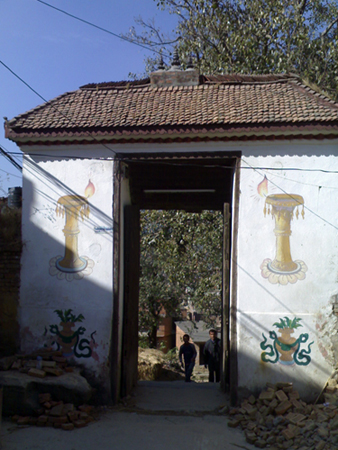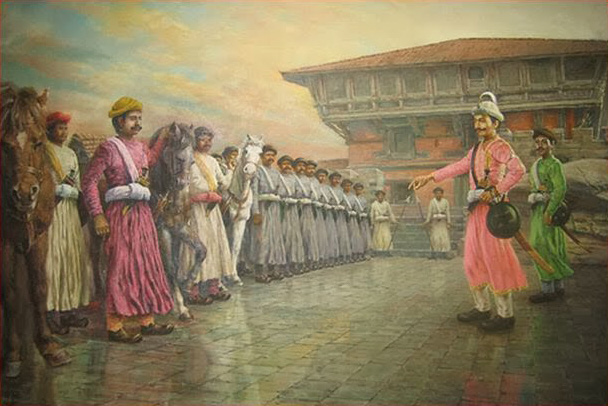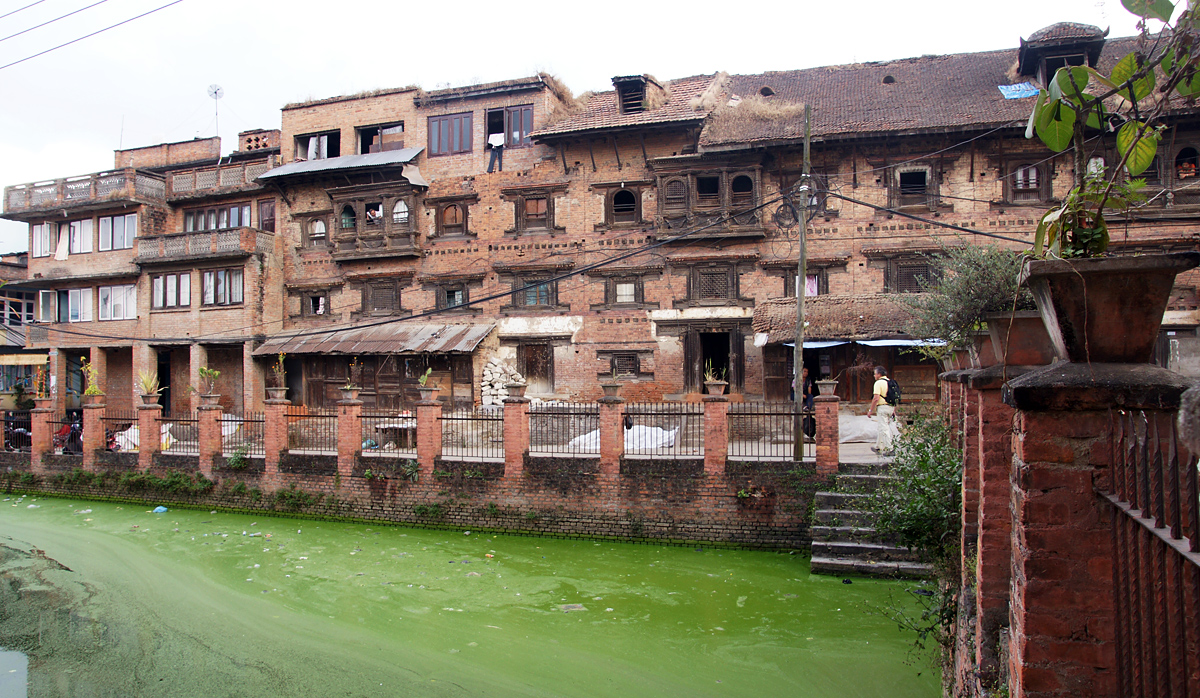|
Kalu Pandey
Vamshidhar Pande ( ne, वंशीधर पाँडे) known by Alias Kalu Pande ( ne, कालु पाँडे) was a Nepalese politician and military general who was appointed as Kaji of The Gorkha Kingdom. He was born in 1713 A.D. in Gorkha. He was the commander of the Gorkhali forces during the Unification Campaign of Nepal who died in the first Battle of Kirtipur in 1757 A.D. Pande's real name was Banshidhar Pande. He was a son of ''Kaji'' Bhimraj Pande who was minister during reign of King Prithivipati Shah of Gorkha. He was descendant of Minister of Gorkha and Dravya Shah's accomplice Ganesh Pande. He had three sons: ''Dewan Kajisaheb'' Vamsharaj Pande, Sardar Ranasur Pande and ''Mulkaji Sahib'' Damodar Pande (1st PM of Nepal). Family Pande was born in 1713 A.D to ''Kaji Bhimraj Pande''. He was a descendant of Ganesh Pande, who was the first Kaji (Prime Minister) of King Dravya Shah of Gorkha Kingdom established in 1559 A.D. The Pandes were considered as Thar ... [...More Info...] [...Related Items...] OR: [Wikipedia] [Google] [Baidu] |
Kaji (Nepal)
''Kaji'' ( ne, काजी) was a title and position used by nobility of Gorkha Kingdom (1559–1768) and Kingdom of Nepal between 1768 and 1846. Many other contemporary kingdoms used the same title for their ministers. Etymology Historian Mahesh Chandra Regmi suggests that ''Kaji'' is derived from Sanskrit word ''Karyi'' which meant functionary. History Ganesh Pande was the first Kaji under King Dravya Shah of Gorkha Kingdom. He helped Dravya Shah to become King of Gorkha and was later appointed Kaji of Gorkha in 1559 A.D. Another significant Kaji of Gorkha was Kalu Pande born in the family of Ganesh Pande. He was son of Bhimraj Pande who was also a Kaji during the reign of King Nara Bhupal Shah. Kalu Pande led Gorkhalis in the Battle of Kirtipur. He had set up a base on Naikap, a hill on the valley's western rim, from where they were to mount their assaults on Kirtipur. He was killed in the battle after being surrounded by enemy forces. The ministers and officials of Kantipur ... [...More Info...] [...Related Items...] OR: [Wikipedia] [Google] [Baidu] |
Unification Campaign Of Nepal
The Unification of Nepal, also known as Expansion of Gorkha Kingdom, officially began in 1743 AD (1799 BS) after King Prithvi Narayan Shah of Gorkha launched an aggressive annexation campaign seeking to broaden his own kingdom's border. After conquering the Nepal Mandala, which consisted of the different city-states of the Kathmandu, Lalitpur, Kirtipur and Bhaktapur, Shah moved his hilly capital in Gorkha to the fertile and wealthy city of Kathmandu and adopted the name Nepal for the entire Gorkha Empire. The Shah dynasty would go on to expand the various warring kingdoms that once occupied parts of present-day Nepal into a nation-state that stretched up to the Sutlej River in the west and Sikkim-Jalpaiguri in the east. Before usage by the Gorkha Empire, the Kathmandu Valley was known as Nepal after the Nepal Mandala, the region's Nepal Bhasa name. Invasion of Nuwakot Prithvi Narayan Shah's annexation campaign began with the nearby kingdom of Nuwakot. Nuwakot marked the eas ... [...More Info...] [...Related Items...] OR: [Wikipedia] [Google] [Baidu] |
Kirtipur City Gate
Kirtipur (Nepal Bhasa: किपू ''Kipoo'') is a Municipality and an ancient city of Nepal. The Newars are the natives of Kipoo (Kirtipur) that is believed to be derived from Kirati King Yalamber. It is located in the Kathmandu Valley 5 km south-west of the city of Kathmandu. It is one of the five municipalities in the valley, the others being Kathmandu, Lalitpur, Bhaktapur and Madhyapur Thimi. It is one of the most famous and religious places to visit. Many people visit this place not only for its natural environment but also to visit temples. The city was listed as a UNESCO tentative site in 2008. Etymology The name Kirtipur comes from the Sanskrit terms ''Kirti'' (glory) and ''pur'' (city) as well as Kirat Kingdom of Yalamber's dynasty. The colloquial term used for the city is Kipoo . Demographics Originally a Newar foundation, Kirtipur is still a center of Newar culture. It has been merged with surrounding villages to form the municipality of Kirtipur with a populatio ... [...More Info...] [...Related Items...] OR: [Wikipedia] [Google] [Baidu] |
Musket
A musket is a muzzle-loaded long gun that appeared as a smoothbore weapon in the early 16th century, at first as a heavier variant of the arquebus, capable of penetrating plate armour. By the mid-16th century, this type of musket gradually disappeared as the use of heavy armour declined, but ''musket'' continued as the generic term for smoothbore long guns until the mid-19th century. In turn, this style of musket was retired in the 19th century when rifled muskets (simply called rifles in modern terminology) using the Minié ball (invented by Claude-Étienne Minié in 1849) became common. The development of breech-loading firearms using self-contained cartridges (introduced by Casimir Lefaucheux in 1835) and the first reliable repeating rifles produced by Winchester Repeating Arms Company in 1860 also led to their demise. By the time that repeating rifles became common, they were known as simply "rifles", ending the era of the musket. Etymology According to the Online Et ... [...More Info...] [...Related Items...] OR: [Wikipedia] [Google] [Baidu] |
Biraj Thapa Magar
Kaji Biraj Thapa Magar (died 1721) played an important role in the Gorkha Kingdom. His leadership, prudence and courage all exhibit he was one of the important Gorkha Bhardars (गोरखाली भारदार) that helped Narbaupal Shah become King of Gorkha. He may also be seen as a 'King Maker' in the modern day term. According to different genealogies, he had taken Narabhupal Shah and his mother Malikavati in custody for three months. The Queen Mother and her son were secretly protected at his residence. After the death of his grandfather, Narabhupal Shah became the King of Gorkha in 1716 and died in 1743. His son, King Prithvi Narayan Shah, succeeding him began unification of small principalities to found modern Nepal. Birth, childhood and education No record so far is available as to when and where was Biraj Thapa Magar born but according to Prithvidhoj Thapa Magar's report, he died 4 years after Narbhupal Shah's accession to the throne of Gorkha Kingdom in 1716 whi ... [...More Info...] [...Related Items...] OR: [Wikipedia] [Google] [Baidu] |
Rishikesh Shah
Rishikesh Shah (May 16, 1925 – November 13, 2002) was a Nepalese writer, politician and human rights activist.Rishikesh Shah, 77 - Nepali Times Career Political Shah was a member of the Nepal Prajatantrik Party from 1948 to 1949. Between 1951 and 1953, he was the general secretary of the . He then became general secretary of the joint |
First Cousin
Most generally, in the lineal kinship system used in the English-speaking world, a cousin is a type of familial relationship in which two relatives are two or more familial generations away from their most recent common ancestor. Commonly, "cousin" refers to a first cousin – a relative of the same generation whose most recent common ancestor with the subject is a grandparent. Degrees and removals are separate measures used to more precisely describe the relationship between cousins. ''Degree'' measures the separation, in generations, from the most recent common ancestor(s) to a parent of one of the cousins (whichever is closest), while ''removal'' measures the difference in generations between the cousins themselves, relative to their most recent common ancestor(s). To illustrate usage, a second cousin is a cousin with a ''degree'' of two; there are three (not two) generations from the common ancestor(s). When the degree is not specified, first cousin is assumed. A cousin ... [...More Info...] [...Related Items...] OR: [Wikipedia] [Google] [Baidu] |
Baburam Acharya
Baburam Acharya ( Nepali: बाबुराम आचार्य) (1888–1971 AD) was a Nepalese historian and literary scholar. He is known as the historian laureate () of Nepal. The four part biography of King Prithivi Narayan Shah, founder of Modern Nepal is a key series of work he created. He is known for the study of ancient Nepalese inscriptions. Sagarmatha Nepal’s eminent historian late Baburam Acharya is credited with the Nepali name Sagarmatha () for Mount Everest that straddles Nepal-China border. Previously, Nepal had no official name of its own for the world’s tallest peak in Nepali, although official name among many Nepalese people - Sherpa Sherpa may refer to: Ethnography * Sherpa people, an ethnic group in north eastern Nepal * Sherpa language Organizations and companies * Sherpa (association), a French network of jurists dedicated to promoting corporate social responsibility * ..., Limbu, etc. existed long ago. What may not be true however is that h ... [...More Info...] [...Related Items...] OR: [Wikipedia] [Google] [Baidu] |
Tularam Pande
Tularam Pande ( ne, तुलाराम पाँडे) was Nepalese military personnel, diplomat and politician in the Gorkha Kingdom. He was a diplomat who served King Prithvi Narayan Shah of Gorkha. Two of his diplomatic missions were with Dolakha and Kathmandu while the latter remained unsuccessful. He also served as the national military commanders in the forces of Prithvi Narayan Shah. He was the patron of the Gora Pande clan, a minor faction of the Gorkha-based aristocratic Pande family. Some of his patrilineal descendants became influential politicians such as Ranajit Pande and Dalabhanjan Pande in the Nepalese history through their marital ties with the Thapa dynasty. His matrilineal descendants became significantly influential; Queen Tripurasundari of Nepal went on to become Queen Mother of Nepal and Mathawar Singh Thapa – the Prime Minister of Nepal and Jang Bahadur Kunwar Ranaji – the latter period ruler of Kaski and Lamjung and Prime Minister of Nepal. Ances ... [...More Info...] [...Related Items...] OR: [Wikipedia] [Google] [Baidu] |
Kunwar Family
The Kunwar family ( ne, कुँवर परिवार) was a noble Khas-Chhetri family in the Gorkha Kingdom and the Kingdom of Nepal. Kunwars were linked to the Thapa dynasty and family of Amar Singh Thapa by marital lineages and, thus, to Pande dynasty through the Thapa dynasty. Three branches of the Kunwars; Ramakrishna, Jayakrishna and Amar Singh Kunwar were formed with opposite political aspirations. Bal Narsingh Kunwar (of Ramkrishna section) supported ''Mukhtiyar'' Bhimsen Thapa while Chandrabir Kunwar (of Jayakrishna section) supported ''Bada Kaji'' Amar Singh Thapa due to their marital relations with those families. Later, the Ramakrishna section of the family including Amarsingh established the Rana dynasty of Nepal and styled themselves as Rana Rajputs while Jayakrishna most section remained as Kunwars. Origins Genealogy The Kunwars of Nepal claim descent from a Rajput man named Ram Singh, who was said to belong to Kshatriya Varna. He was considered to have settl ... [...More Info...] [...Related Items...] OR: [Wikipedia] [Google] [Baidu] |
Thapa Dynasty
Thapa dynasty or Thapa noble family ( ne, थापा वंश/थापा काजी खलक ) was a Kshatriya political family that handled Nepali administration affairs between 1806 and 1837 A.D. and 1843 to 1845 A.D. as Mukhtiyar (Prime Minister). This was one of the four noble families to be involved in the active politics of the Kingdom of Nepal, along with the Shah dynasty, Basnyat family, and the Pande dynasty before the rise of the Rana dynastyor Kunwar family. At the end of 18th century, Thapas had extreme dominance over Nepalese Darbar politics alternatively contesting for central power against the Pande family. Bir Bhadra Thapa was a Thapa of Chhetri group and leading Bharadar during Unification of Nepal. His grandson Bhimsen Thapa became Mukhtiyar of Nepal and established Thapa dynasty to the dominating position of central court politics of Nepal. The Thapa family gave rise to the Rana dynasty of Jung Bahadur Kunwar Rana whose father Bal Narsingh Kun ... [...More Info...] [...Related Items...] OR: [Wikipedia] [Google] [Baidu] |








.jpg)